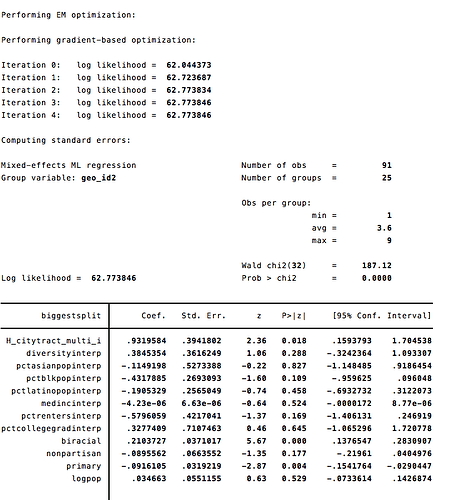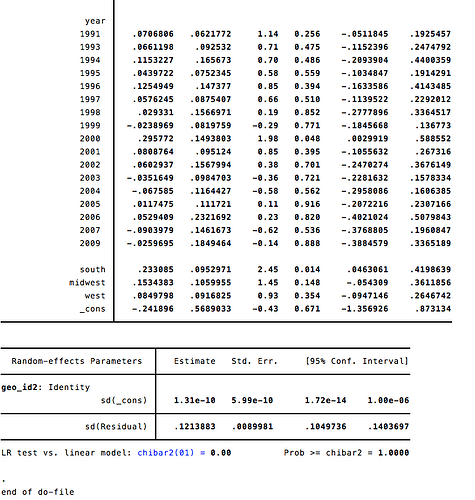Hi all. I am trying to replicate a Stata paper in R and am having an issue where the results of a multi-level mixed-effects linear regression are very similar, but slightly off (especially the standard errors). I am wondering if anyone knows why this is happening. I am using the exact same dataset in both specifications (which can be found here). The Stata code I am trying to replicate is:
use "/Users/mariaburzillo/Desktop/GOV1006/final_project/racial_polarization_winners.dta", clear
xtmixed biggestsplit H_citytract_multi_i diversityinterp pctasianpopinterp pctblkpopinterp pctlatinopopinterp medincinterp pctrentersinterp pctcollegegradinterp biracial nonpartisan primary logpop i. year south midwest west if winner==1||geo_id2:
Which gives the following output:
The reprex for my attempt to replicate this in R is:
library(haven)
library(tidyverse)
library(lme4)
#> Loading required package: Matrix
#>
#> Attaching package: 'Matrix'
#> The following objects are masked from 'package:tidyr':
#>
#> expand, pack, unpack
library(reprex)
# load data
rp <- read_dta("/Users/mariaburzillo/Desktop/GOV1006/final_project/racial_polarization_winners.dta")
# create factor variable for year
rp$year.f <- as.factor(rp$year)
# apply condition that winner == 1 as in Stata regression
rp_sub <- rp %>%
filter(winner == 1)
# multi-level mixed effects regression with random effects for geo_id2
m1 <- lmer(biggestsplit ~ H_citytract_multi_i + diversityinterp + pctasianpopinterp + pctblkpopinterp + pctlatinopopinterp + medincinterp + pctrentersinterp + pctcollegegradinterp + biracial + nonpartisan + primary + logpop + year.f + south + midwest + west + (1 | geo_id2), data = rp_sub)
#> Warning: Some predictor variables are on very different scales: consider
#> rescaling
#> boundary (singular) fit: see ?isSingular
# summarize
summary(m1)
#> Linear mixed model fit by REML ['lmerMod']
#> Formula:
#> biggestsplit ~ H_citytract_multi_i + diversityinterp + pctasianpopinterp +
#> pctblkpopinterp + pctlatinopopinterp + medincinterp + pctrentersinterp +
#> pctcollegegradinterp + biracial + nonpartisan + primary +
#> logpop + year.f + south + midwest + west + (1 | geo_id2)
#> Data: rp_sub
#>
#> REML criterion at convergence: -5.2
#>
#> Scaled residuals:
#> Min 1Q Median 3Q Max
#> -2.0918 -0.4281 0.0000 0.5283 1.9850
#>
#> Random effects:
#> Groups Name Variance Std.Dev.
#> geo_id2 (Intercept) 0.00000 0.000
#> Residual 0.02312 0.152
#> Number of obs: 91, groups: geo_id2, 25
#>
#> Fixed effects:
#> Estimate Std. Error t value
#> (Intercept) -2.419e-01 7.126e-01 -0.339
#> H_citytract_multi_i 9.320e-01 4.937e-01 1.888
#> diversityinterp 3.845e-01 4.530e-01 0.849
#> pctasianpopinterp -1.149e-01 6.605e-01 -0.174
#> pctblkpopinterp -4.318e-01 3.373e-01 -1.280
#> pctlatinopopinterp -1.905e-01 3.213e-01 -0.593
#> medincinterp -4.225e-06 8.304e-06 -0.509
#> pctrentersinterp -5.796e-01 5.282e-01 -1.097
#> pctcollegegradinterp 3.277e-01 8.903e-01 0.368
#> biracial 2.104e-01 4.647e-02 4.527
#> nonpartisan -8.956e-02 8.312e-02 -1.077
#> primary -9.161e-02 3.998e-02 -2.291
#> logpop 3.466e-02 6.904e-02 0.502
#> year.f1991 7.068e-02 7.788e-02 0.908
#> year.f1993 6.612e-02 1.159e-01 0.570
#> year.f1994 1.153e-01 2.075e-01 0.556
#> year.f1995 4.397e-02 9.424e-02 0.467
#> year.f1996 1.255e-01 1.846e-01 0.680
#> year.f1997 5.762e-02 1.097e-01 0.526
#> year.f1998 2.933e-02 1.963e-01 0.149
#> year.f1999 -2.390e-02 1.027e-01 -0.233
#> year.f2000 2.958e-01 1.871e-01 1.581
#> year.f2001 8.088e-02 1.192e-01 0.679
#> year.f2002 6.029e-02 1.964e-01 0.307
#> year.f2003 -3.516e-02 1.233e-01 -0.285
#> year.f2004 -6.759e-02 1.459e-01 -0.463
#> year.f2005 1.175e-02 1.399e-01 0.084
#> year.f2006 5.294e-02 2.908e-01 0.182
#> year.f2007 -9.040e-02 1.831e-01 -0.494
#> year.f2009 -2.597e-02 2.317e-01 -0.112
#> south 2.331e-01 1.194e-01 1.953
#> midwest 1.534e-01 1.328e-01 1.156
#> west 8.498e-02 1.148e-01 0.740
#>
#> Correlation matrix not shown by default, as p = 33 > 12.
#> Use print(x, correlation=TRUE) or
#> vcov(x) if you need it
#> fit warnings:
#> Some predictor variables are on very different scales: consider rescaling
#> convergence code: 0
#> boundary (singular) fit: see ?isSingular
In response to a request for an example from a built-in dataset, etc., here is an alternative reprex using the EmplUK dataset from the plm package:
library(tidyverse)
library(lme4)
#> Loading required package: Matrix
#>
#> Attaching package: 'Matrix'
#> The following objects are masked from 'package:tidyr':
#>
#> expand, pack, unpack
library(reprex)
library(plm)
#>
#> Attaching package: 'plm'
#> The following objects are masked from 'package:dplyr':
#>
#> between, lag, lead
# load data from plm package
data("EmplUK", package="plm")
# multi-level mixed effects regression with random effects for firm
m4 <- lmer(wage ~ as.factor(year) + sector + emp + capital +
output + (1 | firm), data = EmplUK)
# summarize
summary(m4)
#> Linear mixed model fit by REML ['lmerMod']
#> Formula: wage ~ as.factor(year) + sector + emp + capital + output + (1 |
#> firm)
#> Data: EmplUK
#>
#> REML criterion at convergence: 4841.1
#>
#> Scaled residuals:
#> Min 1Q Median 3Q Max
#> -6.5171 -0.5067 -0.0280 0.4502 7.9279
#>
#> Random effects:
#> Groups Name Variance Std.Dev.
#> firm (Intercept) 21.489 4.636
#> Residual 3.793 1.948
#> Number of obs: 1031, groups: firm, 140
#>
#> Fixed effects:
#> Estimate Std. Error t value
#> (Intercept) 26.57338 1.55552 17.083
#> as.factor(year)1977 -1.99478 0.27950 -7.137
#> as.factor(year)1978 -2.63032 0.27979 -9.401
#> as.factor(year)1979 -2.51523 0.27983 -8.988
#> as.factor(year)1980 -2.33948 0.28846 -8.110
#> as.factor(year)1981 -1.37792 0.32335 -4.261
#> as.factor(year)1982 -0.33180 0.33480 -0.991
#> as.factor(year)1983 0.49106 0.37275 1.317
#> as.factor(year)1984 0.33148 0.43801 0.757
#> sector -0.78632 0.14900 -5.277
#> emp -0.09098 0.02393 -3.801
#> capital 0.17433 0.05542 3.145
#> output 0.03097 0.01132 2.736
#>
#> Correlation matrix not shown by default, as p = 13 > 12.
#> Use print(x, correlation=TRUE) or
#> vcov(x) if you need it
# write to csv for use in stata
write.csv(EmplUK, file = "empUK.csv" )
The corresponding stata command would be:
xtmixed wage i.year sector emp capital output || firm:
With this example, the outputs are again similar, but they are slightly off. I am trying to see if I can exactly reproduce the Stata code in R.
Thank you for the help! Happy to answer any more questions.

